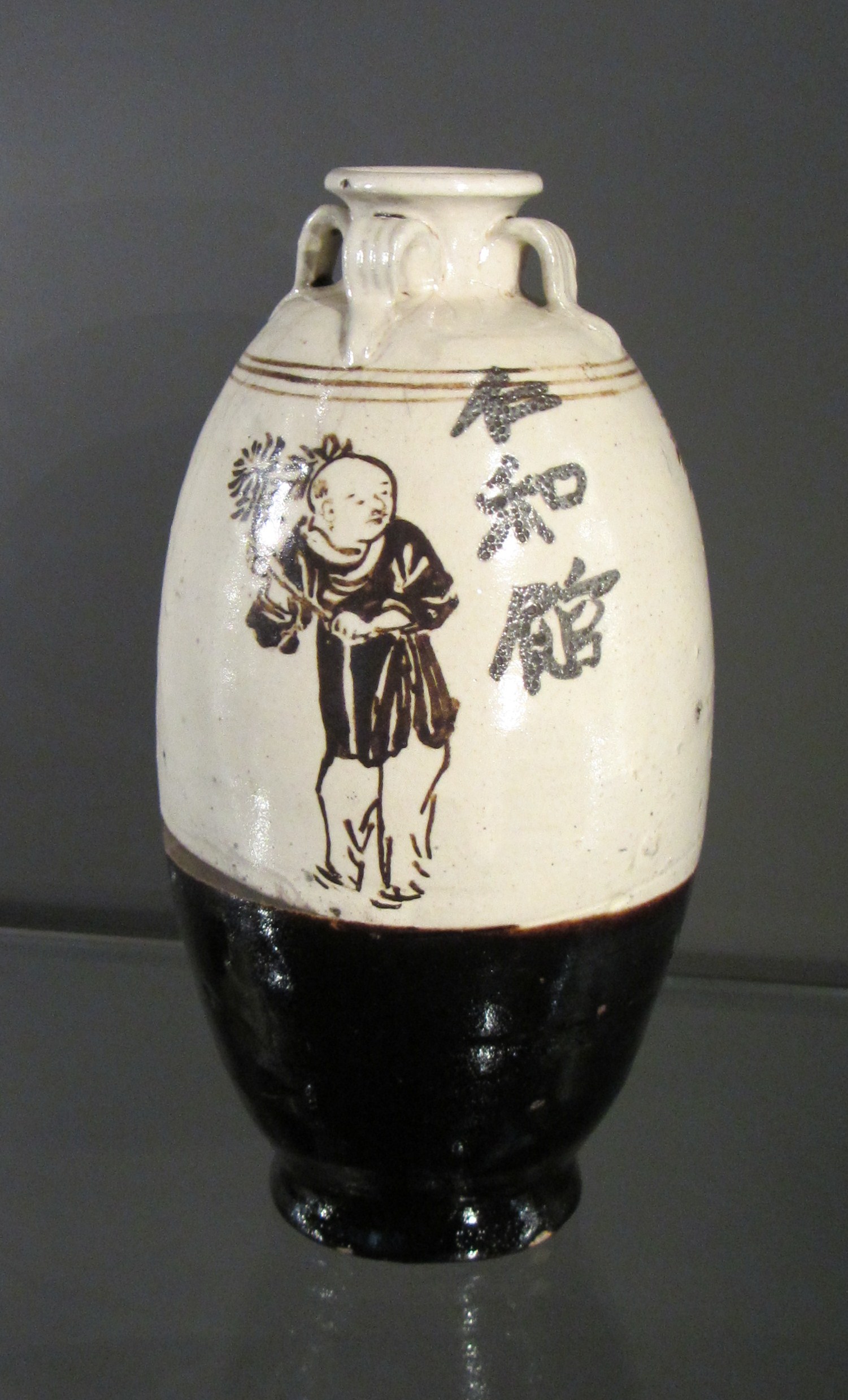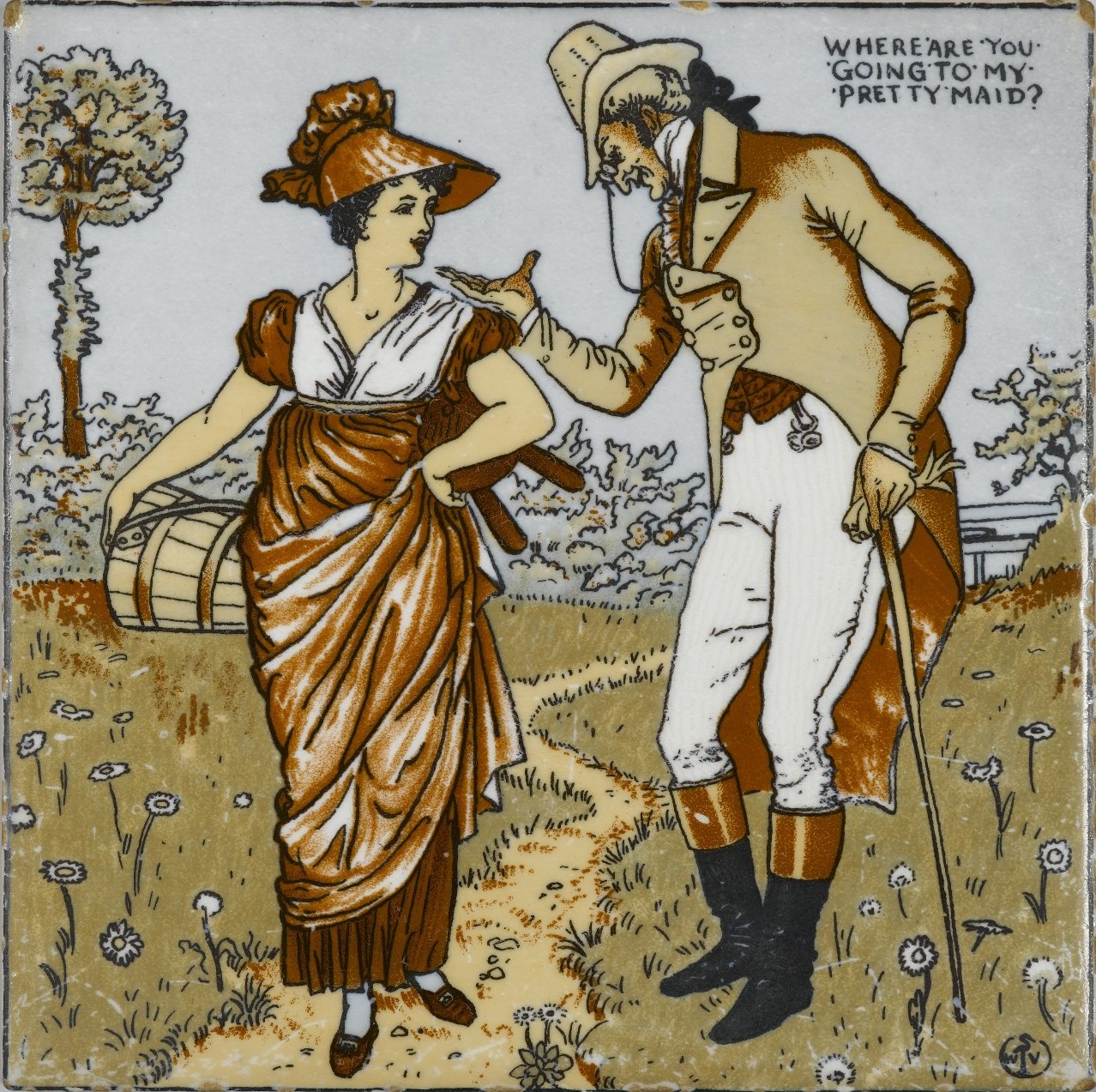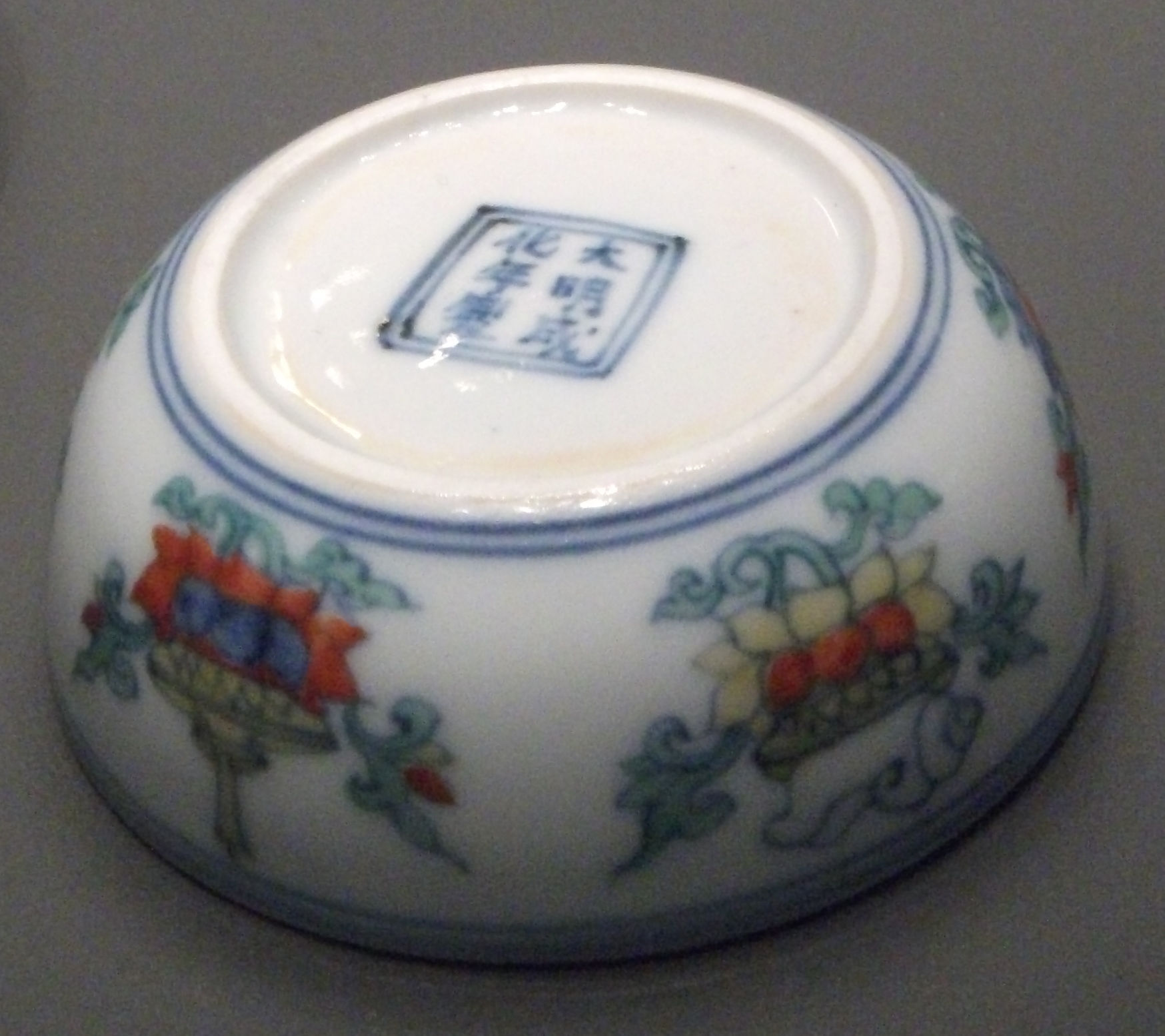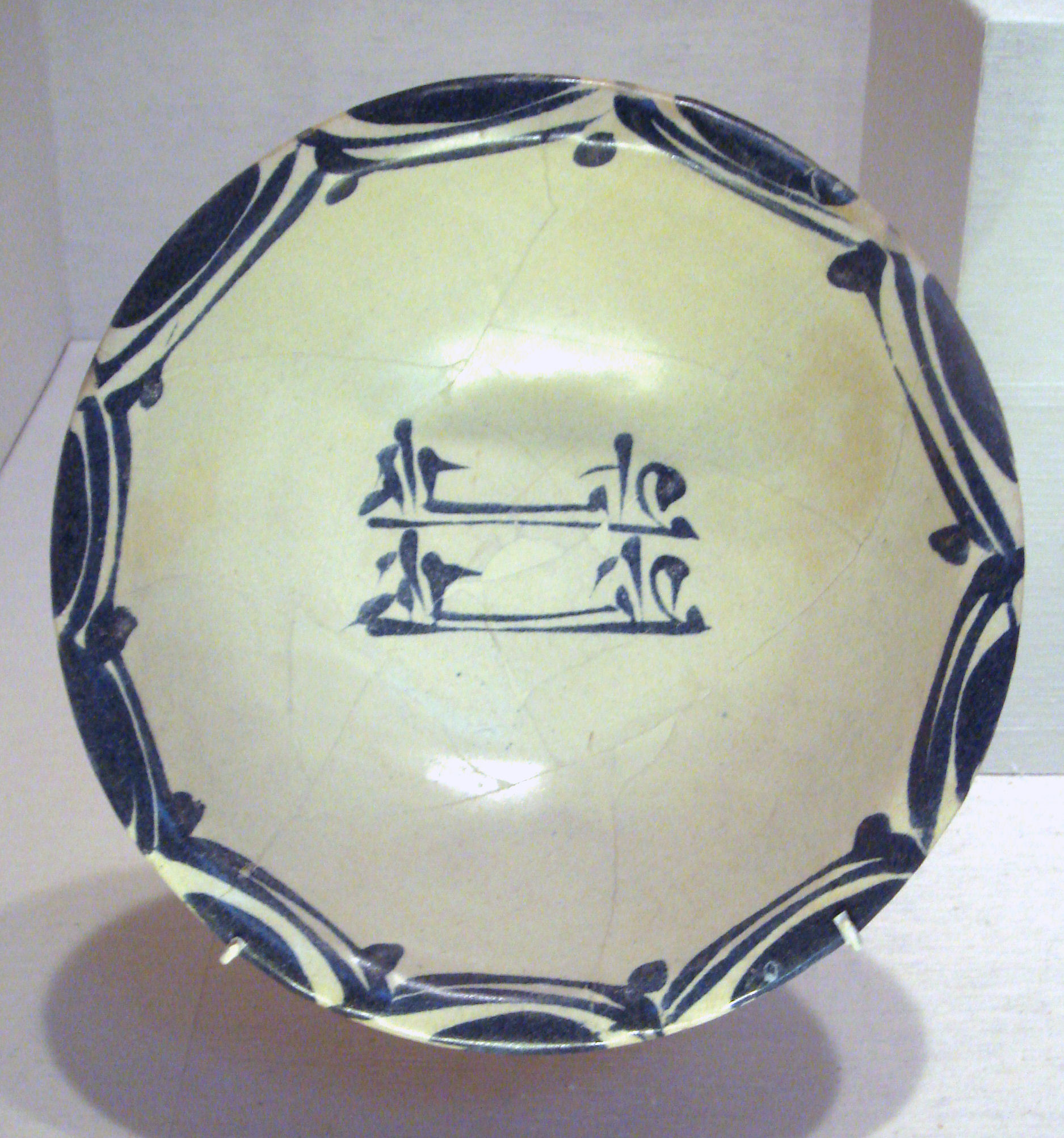|
Overglaze
Overglaze decoration, overglaze enamelling or on-glaze decoration is a method of decorating pottery, most often porcelain, where the coloured decoration is applied on top of the already fired and glazed surface, and then fixed in a second firing at a relatively low temperature, often in a muffle kiln. It is often described as producing "enamelled" decoration. The colours fuse on to the glaze, so the decoration becomes durable. This decorative firing is usually done at a lower temperature which allows for a more varied and vivid palette of colours, using pigments which will not colour correctly at the high temperature necessary to fire the porcelain body. Historically, a relatively narrow range of colours could be achieved with underglaze decoration, where the coloured pattern is applied before glazing, notably the cobalt blue of blue and white porcelain. Many historical styles, for example mina'i ware, Imari ware, Chinese doucai and wucai, combine the two types of decoration. ... [...More Info...] [...Related Items...] OR: [Wikipedia] [Google] [Baidu] |
China Painting
China painting, or porcelain painting, is the decoration of glazed porcelain objects such as plates, bowls, vases or statues. The body of the object may be hard-paste porcelain, developed in China in the 7th or 8th century, or soft-paste porcelain (often bone china), developed in 18th-century Europe. The broader term ceramic painting includes painted decoration on lead-glazed earthenware such as creamware or tin-glazed pottery such as maiolica or faience. Typically the body is first fired in a kiln to convert it into a hard porous biscuit or bisque. Underglaze decoration may then be applied, followed by glaze, which is fired so it bonds to the body. The glazed porcelain may then be painted with overglaze decoration and fired again to bond the paint with the glaze. Most pieces use only one of underglaze or overglaze painting, the latter often being referred to as "enamelled". Decorations may be applied by brush or by stenciling, transfer printing, lithography and screen printing ... [...More Info...] [...Related Items...] OR: [Wikipedia] [Google] [Baidu] |
Chinese Porcelain
Chinese ceramics show a continuous development since pre-dynastic times and are one of the most significant forms of Chinese art and ceramics globally. The first pottery was made during the Palaeolithic era. Chinese ceramics range from construction materials such as bricks and tiles, to hand-built pottery vessels fired in bonfires or kilns, to the sophisticated Chinese porcelain wares made for the imperial court and for export. Porcelain was a Chinese invention and is so identified with China that it is still called "china" in everyday English usage. Most later Chinese ceramics, even of the finest quality, were made on an industrial scale, thus few names of individual potters were recorded. Many of the most important kiln workshops were owned by or reserved for the emperor, and large quantities of Chinese export porcelain were exported as diplomatic gifts or for trade from an early date, initially to East Asia and the Islamic world, and then from around the 16th century to Eur ... [...More Info...] [...Related Items...] OR: [Wikipedia] [Google] [Baidu] |
Kakiemon
is a style of Japanese porcelain, with overglaze decoration called "enameled" ceramics. It was originally produced at the factories around Arita, in Japan's Hizen province (today, Saga Prefecture) from the Edo period's mid-17th century onwards. The style shares much in common with the Chinese "Famille Verte" style. The quality of its decoration was highly prized in the West and widely imitated by major European porcelain manufacturers during the Rococo period. Kakiemon is a term that generates some confusion, being the name of a family, one or more kilns, and a brightly-coloured overglaze style broadly imitating Chinese wares. The style originated with the family, whose kilns were the main producers of it, but other kilns also made it, and the Kakiemon kilns made other styles. Both the palette and style, and very probably the kiln, were in place by the 1680s. The style is a sub-type of what is called in the West Imari ware, the overglaze coloured variety of the broader grouping ... [...More Info...] [...Related Items...] OR: [Wikipedia] [Google] [Baidu] |
Chinese Ceramics
Chinese ceramics show a continuous development since pre-dynastic times and are one of the most significant forms of Chinese art and ceramics globally. The first pottery was made during the Palaeolithic era. Chinese ceramics range from construction materials such as bricks and tiles, to hand-built pottery vessels fired in bonfires or kilns, to the sophisticated Chinese porcelain wares made for the imperial court and for export. Porcelain was a Chinese invention and is so identified with China that it is still called "china" in everyday English usage. Most later Chinese ceramics, even of the finest quality, were made on an industrial scale, thus few names of individual potters were recorded. Many of the most important kiln workshops were owned by or reserved for the emperor, and large quantities of Chinese export porcelain were exported as diplomatic gifts or for trade from an early date, initially to East Asia and the Islamic world, and then from around the 16th century to Euro ... [...More Info...] [...Related Items...] OR: [Wikipedia] [Google] [Baidu] |
Underglaze
Underglaze is a method of decorating pottery in which painted decoration is applied to the surface before it is covered with a transparent ceramic glaze and fired in a kiln. Because the glaze subsequently covers it, such decoration is completely durable, and it also allows the production of pottery with a surface that has a uniform sheen. Underglaze decoration uses pigments derived from oxides which fuse with the glaze when the piece is fired in a kiln. It is also a cheaper method, as only a single firing is needed, whereas overglaze decoration requires a second firing at a lower temperature. Many historical styles, for example Persian mina'i ware, Japanese Imari ware, Chinese doucai and wucai, combine the two types of decoration. In such cases the first firing for the body, underglaze decoration and glaze is followed by the second firing after the overglaze enamels have been applied. However, because the main or glost firing is at a higher temperature than used in overglaze deco ... [...More Info...] [...Related Items...] OR: [Wikipedia] [Google] [Baidu] |
Mina'i Ware
ware is a type of Persian pottery developed in Kashan, Iran, in the decades leading up to the Mongol invasion of Persia in 1219, after which production ceased. It has been described as "probably the most luxurious of all types of ceramic ware produced in the eastern Islamic lands during the medieval period". The ceramic body of white-ish fritware or stonepaste is fully decorated with detailed paintings using several colours, usually including figures. It is significant as the first pottery to use overglaze enamels, painted over the ceramic glaze fixed by a main glost firing; after painting the wares were given a second firing at a lower temperature. "" ( fa, مینایی), a term only used for these wares much later, means "enamelled" in the Persian language. The technique is also known as ''haft-rang'', "seven colours" in Persian. This was the term used by the near-contemporary writer Abu al-Qasim Kasani, who had a pottery background. This technique much later became the ... [...More Info...] [...Related Items...] OR: [Wikipedia] [Google] [Baidu] |
Imari Ware
is a Western term for a brightly-coloured style of Japanese export porcelain made in the area of Arita, in the former Hizen Province, northwestern Kyūshū. They were exported to Europe in large quantities, especially between the second half of the 17th century and the first half of the 18th century. Typically Imari ware (in the English use of the term) is decorated in underglaze blue, with red, gold, black for outlines, and sometimes other colours, added in overglaze. In the most characteristic floral designs most of the surface is coloured, with "a tendency to overdecoration that leads to fussiness". The style was so successful that Chinese and European producers began to copy it. Sometimes the different overglaze styles of Kakiemon and Kutani ware are also grouped under Imari ware. The name derives from the port of Imari, Saga, from which they were shipped to Nagasaki, where the Dutch East India Company and the Chinese had trading outposts. In the West the multi-colour ... [...More Info...] [...Related Items...] OR: [Wikipedia] [Google] [Baidu] |
Cizhou Ware
Cizhou ware or Tz'u-chou ware () is a term for a wide range of Chinese ceramics from between the late Tang dynasty and the early Ming dynasty, but especially associated with the Northern Song to Yuan period in the 11–14th century. It has been increasingly realized that a very large number of sites in northern China produced these wares, and their decoration is very variable, but most characteristically uses black and white, in a variety of techniques. For this reason Cizhou-type is often preferred as a general term. All are stoneware in Western terms, and "high-fired" or porcelain in Chinese terms. They were less high-status than other types such as celadons and Jun ware, and are regarded as "popular", though many are finely and carefully decorated. Alone among major types of Song ceramics their effect largely depends on decoration in contrasting colours, usually in black on white, but sometimes polychrome. At this time, unlike later periods, ceramics for the court were "rel ... [...More Info...] [...Related Items...] OR: [Wikipedia] [Google] [Baidu] |
Transfer Printing
Transfer printing is a method of decorating pottery or other materials using an engraved copper or steel plate from which a monochrome print on paper is taken which is then transferred by pressing onto the ceramic piece. Fleming, John & Hugh Honour. (1977) ''The Penguin Dictionary of Decorative Arts. '' London: Allen Lane, p. 800. Pottery decorated using the technique is known as transferware or transfer ware. It was developed in England from the 1750s on, and in the 19th century became enormously popular in England, though relatively little used in other major pottery-producing countries. The bulk of production was from the dominant Staffordshire pottery industry. America was a major market for English transfer-printed wares, whose imagery was adapted to the American market; several makers made this almost exclusively. The technique was essential for adding complex decoration such as the Willow pattern to relatively cheap pottery. In particular, transfer printing brought ... [...More Info...] [...Related Items...] OR: [Wikipedia] [Google] [Baidu] |
Doucai
''Doucai'' () is a technique in painting Chinese porcelain, where parts of the design, and some outlines of the rest, are painted in underglaze blue, and the piece is then ceramic glaze, glazed and fired. The rest of the design is then added in overglaze enamels of different colours and the piece fired again at a lower temperature of about 850°C to 900°C. The style began in the 15th century under the Ming dynasty in the Jingdezhen ware, imperial factories at Jingdezhen, and its finest products come from a few years in the reign of the Chenghua Emperor, mostly small pieces like the famous Chicken Cup (Chenghua), Chicken cups. The style was discontinued after a few decades, as a suitable overglaze blue was developed, but later revived under the Qing dynasty. It is not to be confused with the ''wucai'' style, which was a related early technique for polychrome painting. ''Doucai'' can be translated as "contrasted colours", "fitted colours", "colours which fit together" or "dove-tail ... [...More Info...] [...Related Items...] OR: [Wikipedia] [Google] [Baidu] |
Wucai
''Wucai'' (五彩, "Five colours", "Wuts'ai" in Wade-Giles) is a style of decorating white Chinese porcelain in a limited range of colours. It normally uses underglaze cobalt blue for the design outline and some parts of the images, and overglaze enamels in red, green, and yellow for the rest of the designs. Parts of the design, and some outlines of the rest, are painted in underglaze blue, and the piece is then glazed and fired. The rest of the design is then added in the overglaze enamels of different colours and the piece fired again at a lower temperature of about 850°C to 900°C. It has its origins in the ''doucai'' technique. The usual distinction made with ''doucai'', which also combines underglaze blue with overglaze enamels in other colours, is that in ''wucai'' only parts of the design include blue, and these cover wider areas, and are often rather freely painted. In ''doucai'' the whole design is outlined in the blue, even if parts are overlaid by the enamels and ... [...More Info...] [...Related Items...] OR: [Wikipedia] [Google] [Baidu] |
Blue And White Porcelain
"Blue and white pottery" () covers a wide range of white pottery and porcelain decorated under the glaze with a blue pigment, generally cobalt oxide. The decoration is commonly applied by hand, originally by brush painting, but nowadays by stencilling or by transfer-printing, though other methods of application have also been used. The cobalt pigment is one of the very few that can withstand the highest firing temperatures that are required, in particular for porcelain, which partly accounts for its long-lasting popularity. Historically, many other colours required overglaze decoration and then a second firing at a lower temperature to fix that. The origin of the blue glazes thought to lie in Iraq, when craftsmen in Basra sought to imitate imported white Chinese stoneware with their own tin-glazed, white pottery and added decorative motifs in blue glazes. Such Abbasid-era pieces have been found in present-day Iraq dating to the 9th century A.D., decades after the opening of a ... [...More Info...] [...Related Items...] OR: [Wikipedia] [Google] [Baidu] |
.jpg)


.jpg)



